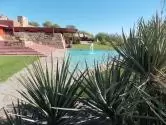Mr. Wright Goes West

Whenever the time comes to find words to describe Frank Lloyd Wright, the superlatives all sound so trite and over-used: genius, brilliant, unequalled, innovative, mastermind.
Wright, of course, found a simple way to describe himself. When called upon to testify in a court case, the bailiff first asked him to state his name and occupation, to which he replied, “Frank Lloyd Wright, the world’s greatest architect.”
Afterwards, his wife suggested that perhaps in the future he try to be a little more modest on the stand. “But, my dear, you don’t understand,” Wright replied. “I was under oath.”
My latest little journey has brought me to Arizona, giving me the opportunity to drive thirty miles northwest of Phoenix, where in 1937 Frank Lloyd Wright surveyed 100 acres of raw, rocky, desolate, waterless dessert, inhabited only by rattlesnakes, bobcats, and coyotes, and where he nevertheless declared, “We’ll build here.”
Wright had hit upon hard times in the 1930s, just as nearly every American had, and so he had started a school for young architects. During the summer months they lived at Taliesin, his Prairie School compound built around 1912 in the lush valley outside Spring Green, Wisconsin, every bit as beautiful and bountiful as its name. But when a winter cold threatened to develop into pneumonia, the 70-year-old Wright took his doctor’s advice and sought a winter refuge in Arizona.

From 1937 until his death in 1957, Wright and his apprentices spent their winters in the dessert, sleeping those first few years in canvas tents at night, while during the day hauling rocks and digging sand out of the dessert to mix with concrete to form the walls of the buildings they would need: a drafting room, a dining hall, Wright’s office and living quarters, and, eventually, even rooms for the apprentices.
And for this opportunity to work for Frank Lloyd Wright, they willingly paid $750 per year.
As I walked around the grounds admiring the architecture that literally defined Wright’s view of “organic architecture” — buildings literally built of the mountain, not on the mountain — I could still see ample evidence of his Prairie School heritage. While redwood had replaced oak, jagged rocks had replaced uniform bricks, and clear glass had replaced leaded glass windows, the buildings maintained their low profiles with long, overhanging eaves that block the rays of the sun while encouraging the relief carried by the cool valley breezes.
Grass does not grow naturally in this climate, and so flagstone terraces and walkways punctuated by shallow pools of water are what constitute a yard at Taliesin West. Doorways are low, prompting tall visitors to quickly learn to duck (or perhaps Wright saw it as us “bowing” to his presence) when entering a room. Wright stood just 5′ 7″, though he had an ego that was closer to 7′ 5″, and once remarked that had he been taller, his buildings would have looked entirely differently.
But he was as unpredictable and he was unprecedented, and loved to surprise his guests, taking them through narrow walkways and low hallways before making a grand entrance into one of his masterpieces.
As I wrote here a few months ago, as he had requested, in 1957 Wright’s body had first been buried in Spring Green, but years later his third wife had also made a request: that he be dug up one night by his apprentices, who had him cremated and his ashes brought back to Taliesin West. Fearful the courts might order their return, Wrights ashes were quickly combined with those of his recently deceased wife and mixed into the mortar for one of the walls.
The staff, should they know the precise location, is sworn to secrecy.
I know, because I tried.
And Frank would have loved it.

Until next Monday,
Have a great week.
Bruce
Top: One of the pools outside the drafting room.
Middle: Frank Lloyd Wright’s office.
